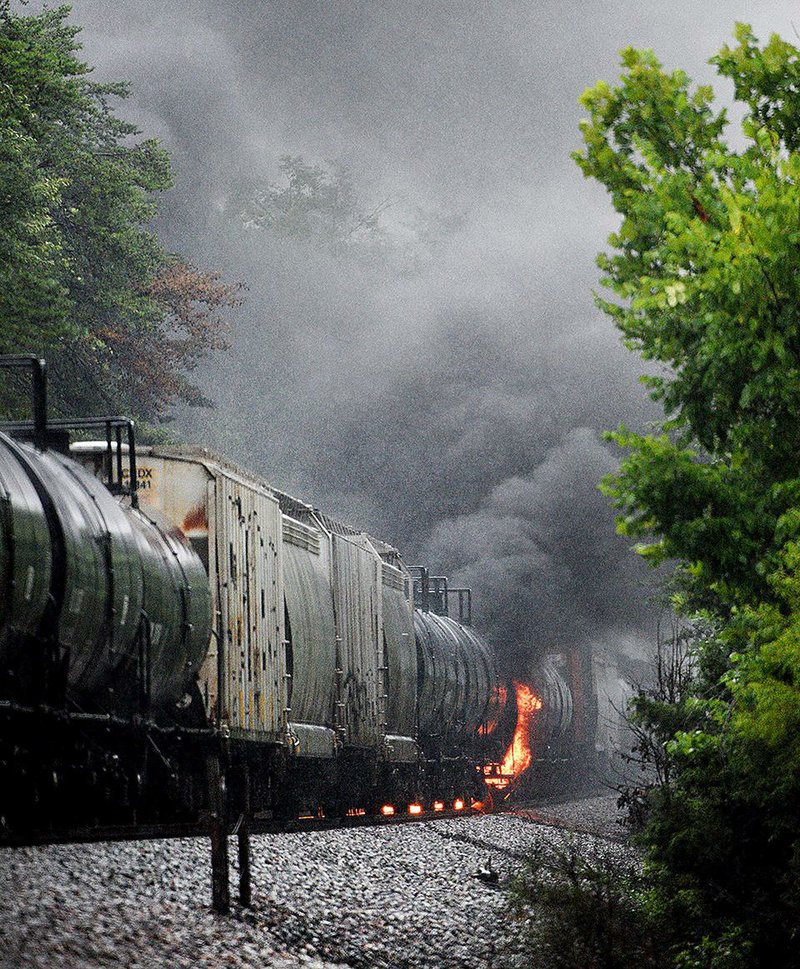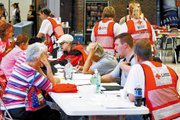MARYVILLE, Tenn. -- Smoke quit rising Thursday afternoon from the site where a CSX train car carrying hazardous material derailed and caught fire in eastern Tennessee, forcing the evacuation of thousands of people, an official said.
Earlier, officials said firefighters had been unable to get close to the burning car because of the heat. Shortly before 6 p.m., Blount County Mayor Ed Mitchell said he and others had visited the site and the smoke had stopped.
Mitchell said there also were concerns that the fumes contained cyanide, a byproduct of the burning of the chemical acrylonitrile, which was leaking from the train car.
Officials said firefighters had been trying to hose down neighboring rail cars and keep them cool while also trying to move them away from the flames.
The derailment late Wednesday prompted the evacuation of thousands of people and several businesses within a mile-and-a-half radius.
The damaged car was carrying liquid acrylonitrile, which officials said is a hazardous material used in multiple industrial processes including making plastics. It's flammable and it's dangerous if inhaled. The Environmental Protection Agency says some effects of breathing acrylonitrile include headaches, dizziness, irritability and rapid heartbeat.
Josh West, spokesman for Blount Memorial Hospital in Maryville, said 52 people had gone in for treatment by Thursday evening, and 25 had been admitted. Some of the others were discharged and some remained in the emergency room for observation, he said. None had life-threatening injuries.
Ten first responders received hospital treatment after breathing fumes.
The train was traveling from Cincinnati to Waycross, Ga., when it derailed around midnight Wednesday.
CSX regional vice president for state government affairs Craig Camuso said it had 57 cars and two locomotives, and that 27 cars carried hazardous chemicals: nine with acrylonitrile, 16 with propane and two with asphalt. He said the cause of the derailment is not yet known.
The Federal Railroad Administration said it had investigators and hazardous-materials inspectors at the scene, and would investigate the cause of the derailment once it was safe.
The National Transportation Safety Board is not investigating the accident, but will monitor it and could send an investigator later, agency spokesman Terry Williams said in an email.
In general, the transportation of hazardous materials in commerce is regulated federal law, Pipeline and Hazardous Materials Safety Administration spokesman Gordon "Joe" Delcambre Jr. said in an email. The law requires that shippers of hazardous materials be registered, the material be properly classified, the handlers have preliminary training and that the material be labeled and held in proper containers
He said more than 1 million daily shipments of hazardous materials are moved across the nation by all modes of transportation.
Maryville is a town of nearly 30,000 people about 20 miles south of Knoxville and just outside the Great Smoky Mountains National Park.
Maryville City Manager Greg McClain advised the approximately 5,000 evacuees to make plans to be away from home at least for Thursday night.
"We're doing our very best to get you back to your homes as soon as possible," he said.
On its Facebook page, the Blount County sheriff's office said early Thursday that the evacuations could last from 24 to 48 hours.
Kevin Eichinger, an on-scene coordinator with the EPA, said air, water and soil samples would be tested. He said early air testing Thursday indicated air quality "around background levels."
McClain said there was no indication yet whether well water was affected, but Mitchell asked residents near the derailment site not to drink well water for now. He said CSX would provide bottled water at an area middle school.
A shelter for residents was set up at a high school. Several residents there said they were not aware of the derailment until they got a call or someone knocked on their doors early in the morning.
"We saw police going back and forth and emergency vehicles going back and forth on our road, but we didn't know why until about 3 to 3:30," Maryville resident John Trull said. "That's when they told us."
Brittany Parrott said she was awakened by a knock on her apartment door about 4:30 a.m. Although she didn't hear the derailment, she said she noticed the effects of it as she went outside.
"You could smell it in the air," Parrott said. "I had a headache, I was feeling nauseated and lightheaded, all the symptoms."
Information for this article was contributed by Adrian Sainz and Rebecca Yonker of The Associated Press.
A Section on 07/03/2015

